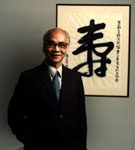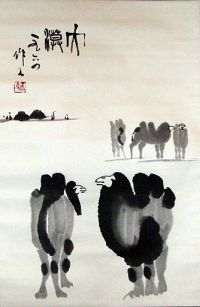Difference between revisions of "Wu Zuoren"
imported>Ciic (Created page with 'thumb|200px|right|Wu Zuoren '''Wu Zuoren''' was a prominent Chinese ink painter, oil painter and art educator. He was once praised by Xu Beihong as "one of t...') |
imported>Ciic |
||
| (2 intermediate revisions by one other user not shown) | |||
| Line 1: | Line 1: | ||
[[File:wzr.jpg|thumb|200px|right|Wu Zuoren]] | [[File:wzr.jpg|thumb|200px|right|Wu Zuoren]] | ||
| − | '''Wu Zuoren''' was a prominent Chinese ink painter, oil painter and art educator. He was once praised by [[Xu Beihong]] as "one of the premier representatives of Chinese artists." His painting Portrait of [[Qi Baishi]] was regarded as an immortal work. | + | '''Wu Zuoren''' (吴作人) was a prominent Chinese ink painter, oil painter and art educator. He was once praised by [[Xu Beihong]] as "one of the premier representatives of Chinese artists." His painting Portrait of [[Qi Baishi]] was regarded as an immortal work. |
Wu Zuoren was born in [[Suzhou]] of [[Jiangsu Province]] on [[CIIC:Selected anniversaries/November 3, 2009|November 3]], [[1908]]. In [[1927]], Wu studied at [[Shanghai Art University]] and then transferred to the [[Nanguo Academy of Arts]]. In [[1928]], he followed Xu Beihong to study at the National Central University in Nanjing and won Xu's recognition and praise. Then, in [[1929]], he went to Europe for further study. He was able to enter the Paris Higher Art School for his excellent sketches and was later admitted to Belgium's Royal Institute of Fine Arts. He was awarded a gold medal in an oil painting competition in [[1931]]. | Wu Zuoren was born in [[Suzhou]] of [[Jiangsu Province]] on [[CIIC:Selected anniversaries/November 3, 2009|November 3]], [[1908]]. In [[1927]], Wu studied at [[Shanghai Art University]] and then transferred to the [[Nanguo Academy of Arts]]. In [[1928]], he followed Xu Beihong to study at the National Central University in Nanjing and won Xu's recognition and praise. Then, in [[1929]], he went to Europe for further study. He was able to enter the Paris Higher Art School for his excellent sketches and was later admitted to Belgium's Royal Institute of Fine Arts. He was awarded a gold medal in an oil painting competition in [[1931]]. | ||
| Line 6: | Line 6: | ||
In [[1935]], at Xu Beihong's invitation, he went back home to teach at the Arts Department at the Central University. | In [[1935]], at Xu Beihong's invitation, he went back home to teach at the Arts Department at the Central University. | ||
| − | [[File:xm.jpg|thumb| | + | [[File:xm.jpg|thumb|center|Pandas Eating Bamboo (1985)]] |
In [[1937]], after the [[War of Resistance Against Japan]] broke out, he organized art activities at the war front. | In [[1937]], after the [[War of Resistance Against Japan]] broke out, he organized art activities at the war front. | ||
He served as the head of teaching and administration, vice president and president of the [[China Central Academy of Fine Arts]] following the founding of the People's Republic of [[China]]. He was also awarded the top literary and art honor by the French government and Chinese Ministry of Culture in [[1985]], as well as the top royal honor by the Belgium king in [[1988]]. He also served as the president of the [[Chinese Artists Association]] and vice president of the [[China Federation of Literary and Art Circles]]. | He served as the head of teaching and administration, vice president and president of the [[China Central Academy of Fine Arts]] following the founding of the People's Republic of [[China]]. He was also awarded the top literary and art honor by the French government and Chinese Ministry of Culture in [[1985]], as well as the top royal honor by the Belgium king in [[1988]]. He also served as the president of the [[Chinese Artists Association]] and vice president of the [[China Federation of Literary and Art Circles]]. | ||
| − | [[File:jy.jpg|thumb| | + | [[File:jy.jpg|thumb|center|Goldfish in Lotus Pond (1978)]] |
| + | |||
Wu advocated that art creation should be oriented toward life, and artists should challenge traditions and try to present individualism. He painted rhinoceroses and camels in the 1940s, pandas in the 1950s and goldfish in the 1970s. | Wu advocated that art creation should be oriented toward life, and artists should challenge traditions and try to present individualism. He painted rhinoceroses and camels in the 1940s, pandas in the 1950s and goldfish in the 1970s. | ||
| + | [[File:Camel Herd by Wu Zuoren, Asian Antiquities large-1-.JPG|thumb|200px|center|Camel Herd by Wu Zuoren]] | ||
Few of Wu's works can be found in the overseas market. Only two kinds of his Chinese paintings, goldfish and pandas, and some oil paintings, were sold in Hong Kong. In September [[1989]], an oil painting, Chongqing, sold for 120,000 Hong Kong dollars. His goldfish paintings were favorites among collectors. | Few of Wu's works can be found in the overseas market. Only two kinds of his Chinese paintings, goldfish and pandas, and some oil paintings, were sold in Hong Kong. In September [[1989]], an oil painting, Chongqing, sold for 120,000 Hong Kong dollars. His goldfish paintings were favorites among collectors. | ||
| + | |||
| + | |||
| + | |||
| + | *[http://www.asian-antiquites.com/artist-biographies-pg3 A Brief Biography of and Paintings by Wu Zuoren] | ||
[[Category:painters]] | [[Category:painters]] | ||
Latest revision as of 07:39, 2 August 2013
Wu Zuoren (吴作人) was a prominent Chinese ink painter, oil painter and art educator. He was once praised by Xu Beihong as "one of the premier representatives of Chinese artists." His painting Portrait of Qi Baishi was regarded as an immortal work.
Wu Zuoren was born in Suzhou of Jiangsu Province on November 3, 1908. In 1927, Wu studied at Shanghai Art University and then transferred to the Nanguo Academy of Arts. In 1928, he followed Xu Beihong to study at the National Central University in Nanjing and won Xu's recognition and praise. Then, in 1929, he went to Europe for further study. He was able to enter the Paris Higher Art School for his excellent sketches and was later admitted to Belgium's Royal Institute of Fine Arts. He was awarded a gold medal in an oil painting competition in 1931.
In 1935, at Xu Beihong's invitation, he went back home to teach at the Arts Department at the Central University.
In 1937, after the War of Resistance Against Japan broke out, he organized art activities at the war front.
He served as the head of teaching and administration, vice president and president of the China Central Academy of Fine Arts following the founding of the People's Republic of China. He was also awarded the top literary and art honor by the French government and Chinese Ministry of Culture in 1985, as well as the top royal honor by the Belgium king in 1988. He also served as the president of the Chinese Artists Association and vice president of the China Federation of Literary and Art Circles.
Wu advocated that art creation should be oriented toward life, and artists should challenge traditions and try to present individualism. He painted rhinoceroses and camels in the 1940s, pandas in the 1950s and goldfish in the 1970s.
Few of Wu's works can be found in the overseas market. Only two kinds of his Chinese paintings, goldfish and pandas, and some oil paintings, were sold in Hong Kong. In September 1989, an oil painting, Chongqing, sold for 120,000 Hong Kong dollars. His goldfish paintings were favorites among collectors.



